2003 GMC SIERRA DENALI maintenance
[x] Cancel search: maintenancePage 225 of 428
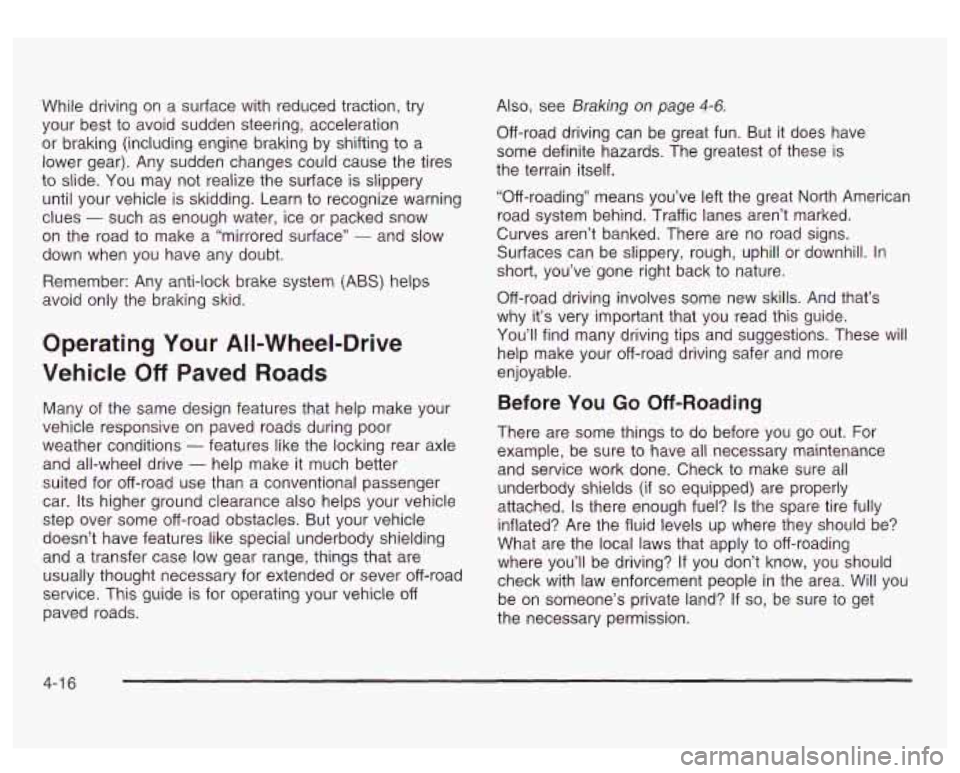
While driving on a surface with reduced traction, try
your best to avoid sudden steering, acceleration
or braking (including engine braking by shifting to a
lower gear). Any sudden changes could cause the tires
to slide. You may not realize the surface is slippery
until your vehicle
is skidding. Learn to recognize warning
clues
- such as enough water, ice or packed snow
on the road to make a “mirrored surface”
- and slow
down when you have any doubt.
Remember: Any anti-lock brake system (ABS) helps
avoid only the braking skid.
Operating Your All-Wheel-Drive
Vehicle
Off Paved Roads
Many of the same design features that help make your
vehicle responsive on paved roads during poor
weather conditions
- features like the locking rear axle
and all-wheel drive
- help make it much better
suited for off-road use than a conventional passenger
car. Its higher ground clearance also helps your vehicle
step over some off-road obstacles. But your vehicle
doesn’t have features like special underbody shielding
and a transfer case low gear range, things that are
usually thought necessary for extended or sever off-road
service. This guide
is for operating your vehicle off
paved roads.
Also, see Braking on page 4-6.
Off-road driving can be great fun. But it does have
some definite hazards. The greatest of these is
the terrain itself.
“Off-roading” means you’ve left the great North American\
road system behind. Traffic lanes aren’t marked.
Curves aren’t banked. There are no road signs.
Surfaces can be slippery, rough, uphill or downhill. In
short, you’ve gone right back to nature.
Off-road driving involves some new skills. And that’s
why it’s very important that
you read this guide.
You’ll find many driving tips and suggestions. These will
help make your off-road driving safer and more
enjoyable.
Before You Go Off-Roading
There are some things to do before you go out. For
example, be sure to have all necessary maintenance
and service work done. Check to make sure all
underbody shields (if
so equipped) are properly
attached.
Is there enough fuel? Is the spare tire fully
inflated? Are the fluid levels up where they should be?
What are the local laws that apply to off-roading
where you’ll be driving?
If you don’t know, you should
check with law enforcement people in the area. Will you
be on someone’s private land? If
so, be sure to get
the necessary permission.
4-1 6
Page 237 of 428
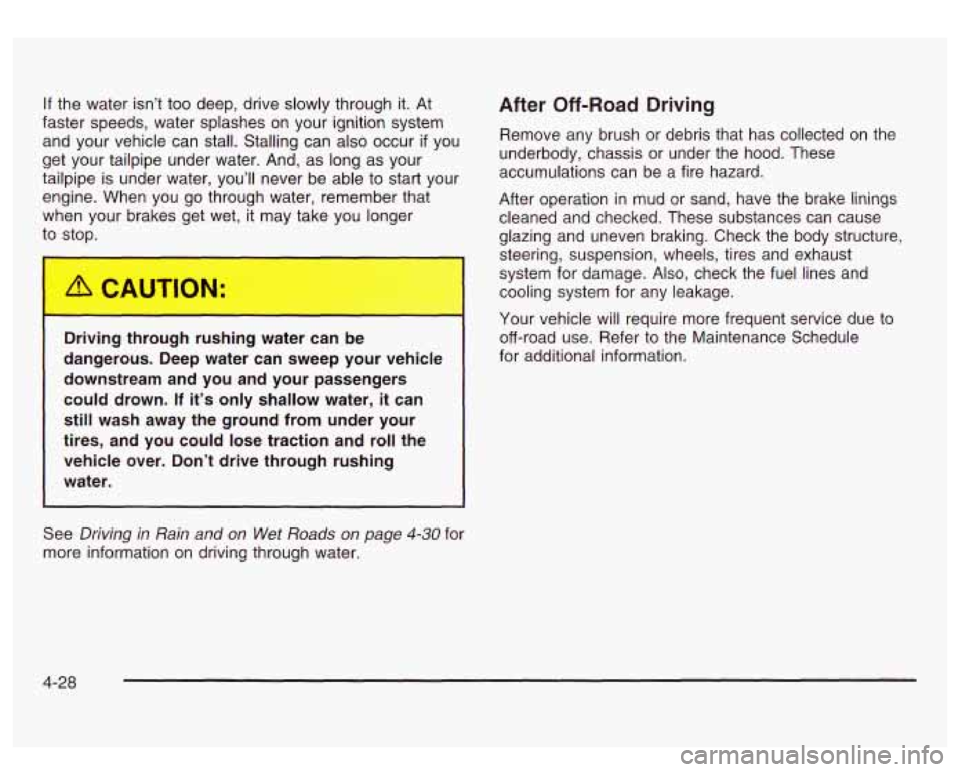
If the water isn’t too deep, drive slowly through it. At
faster speeds, water splashes on your ignition system
and your vehicle can stall. Stalling can also occur
if you
get your tailpipe under water. And, as long as your
tailpipe is under water, you’ll never be able to start your
engine. When you go through water, remember that
when your brakes get wet, it may take you longer
+- stop.
,,jving thr,,gh rushing water can be
dangerous. Deep water can sweep your vehicle
downstream and you and your passengers
could drown. If it’s only shallow water, it can
still wash away the ground from under your
tires, and you could lose traction and roll the
water.
~ vehicle over. Don’t drive through rushing
I
After Off-Road Driving
Remove any brush or debris that has collected on the
underbody, chassis or under the hood. These
accumulations can be a fire hazard.
After operation
in mud or sand, have the brake linings
cleaned and checked. These substances can cause
glazing and uneven braking. Check the body structure,
steering, suspension, wheels, tires and exhaust
system for damage. Also, check the fuel lines and
cooling system for any leakage.
Your vehicle will require more frequent service due
to
off-road use. Refer to the Maintenance Schedule
for additional information.
See
Driving in Rain and on Wet Roads on page 4-30 for
more information on driving through water.
4-28
Page 260 of 428
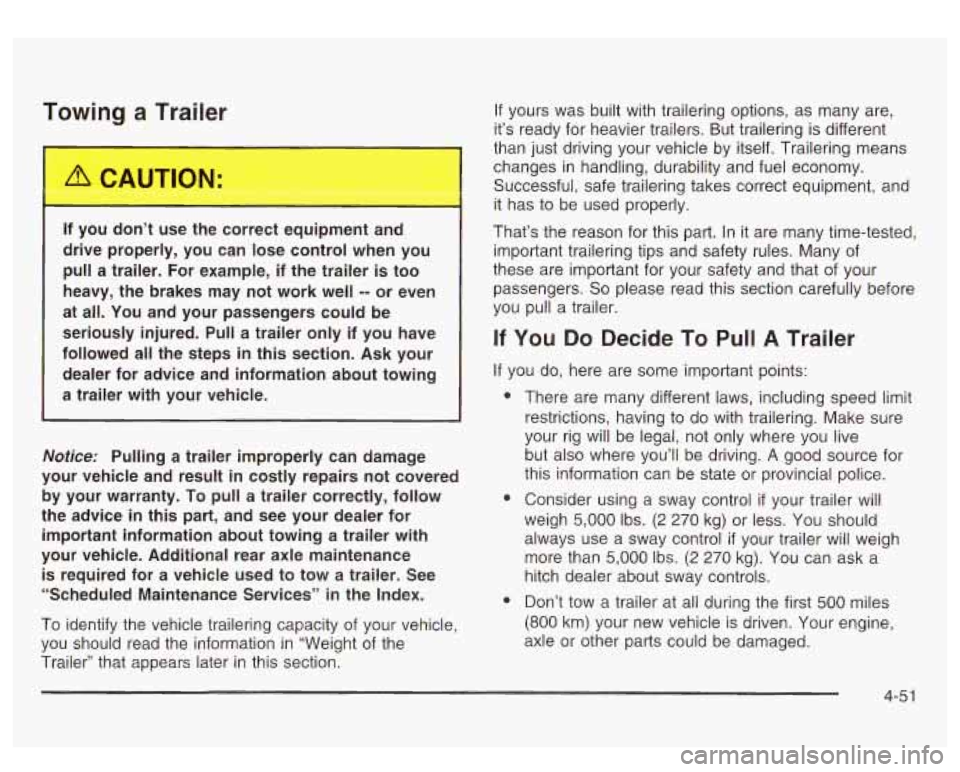
Towing a Trailer
If you don’t ,se the correct eq-., ...__. t and
drive properly, you can lose control when you
pull a trailer. For example,
if the trailer is too
heavy, the brakes may not work well
-- or even
at all. You and your passengers could be
seriously injured.
Pull a trailer only if you have
followed all the steps in this section.
Ask your
dealer for advice and information about towing
a trailer with your vehicle.
Notice: Pulling a trailer improperly can damage
your vehicle and result in costly repairs not covered
by your warranty.
To pull a trailer correctly, follow
the advice in this part, and see your dealer for
important information about towing a trailer with
your vehicle. Additional rear axle maintenance is required for a vehicle used to tow a trailer. See
“Scheduled Maintenance Services” in the Index.
To identify the vehicle trailering capacity of your vehicle,
you should read the information in “Weight of the
Trailer” that appears later in this section.
If yours was built with trailering options, as many are,
it’s ready for heavier trailers. But trailering is different
than just driving your vehicle by itself. Trailering means
changes in handling, durability and fuel economy.
Successful, safe trailering takes correct equipment, and it has to be used properly.
That’s the reason for this part. In it are many time-tested,
important trailering tips and safety rules. Many of
these are important for your safety and that of your
passengers.
So please read this section carefully before
you pull a trailer.
If You Do Decide To Pull A Trailer
If you do, here are some important points:
e
There are many different laws, including speed limit
restrictions, having to do with trailering. Make sure
your rig will be legal, not only where you live
but also where you’ll be driving.
A good source for
this information can be state or provincial police.
Consider using a sway control
if your trailer will
weigh
5,000 Ibs. (2 270 kg) or less. You should
always use a sway control
if your trailer will weigh
more than
5,000 Ibs. (2 270 kg). You can ask a
hitch dealer about sway controls.
Don’t tow a trailer at all during the first
500 miles
(800 km) your new vehicle is driven. Your engine,
axle or other parts could be damaged.
4-5 1
Page 268 of 428
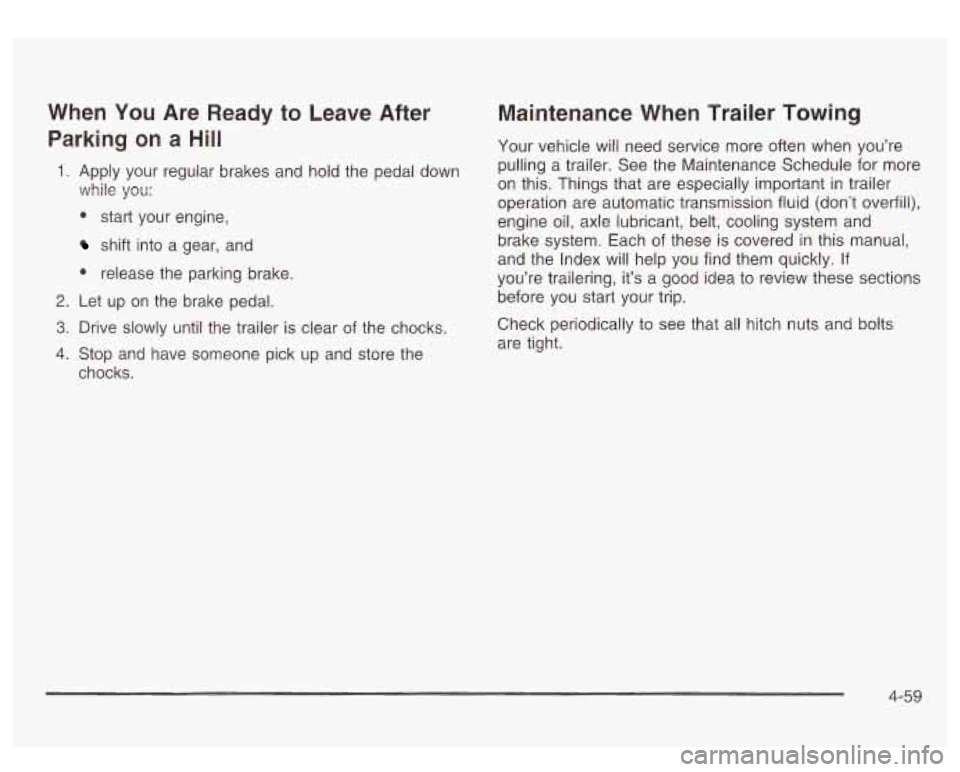
When You Are Ready to Leave After
Parking on a
Hill
1. Apply your regular brakes and hold the pedal down
while you:
0 start your engine,
shift into a gear, and
0 release the parking brake.
2. Let up on the brake pedal.
3. Drive slowly until the trailer is clear of the chocks.
4. Stop and have someone pick up and store the
chocks.
Maintenance When Trailer Towing
Your vehicle will need service more often when you’re
pulling a trailer. See the Maintenance Schedule for more
on this. Things that are especially important in trailer
operation are automatic transmission fluid (don’t overfill),
engine
oil, axle lubricant, belt, cooling system and
brake system. Each of these is covered in this manual,
and the Index will help you find them quickly. If
you’re trailering, it’s a good idea to review these sections
before you start your trip.
Check periodically to see that all hitch nuts and bolts
are tight.
4-59
Page 271 of 428
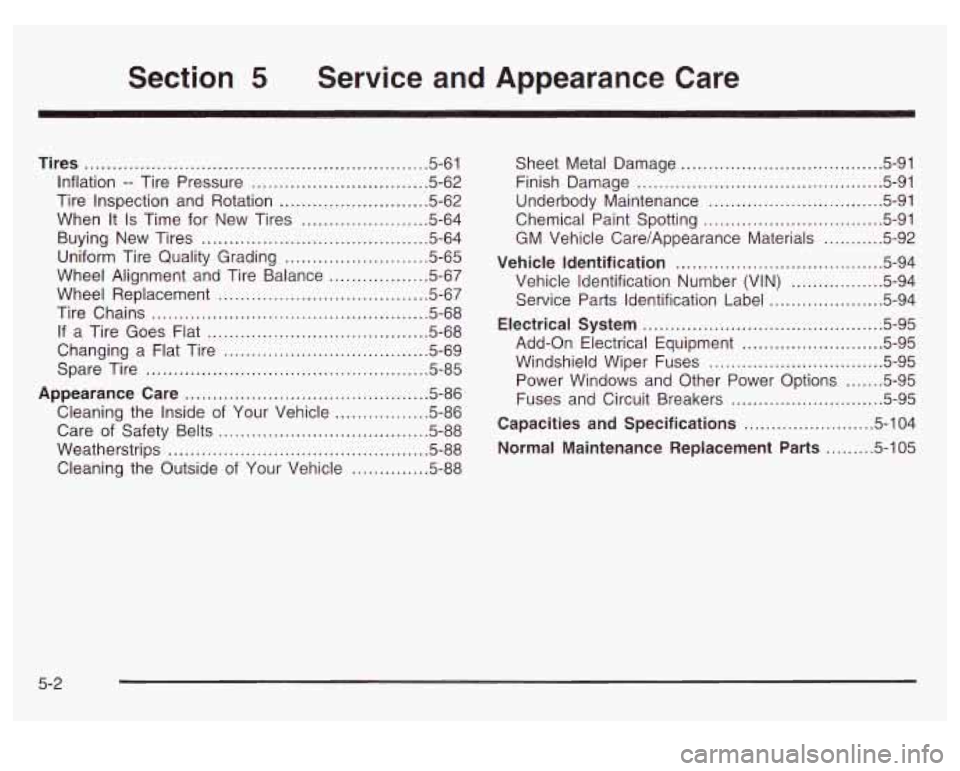
Section 5 Service and Appearance Care
Tires .......................................................... 5-61
Inflation
.. Tire Pressure ................................ 5.62
Tire Inspection and Rotation
........................... 5.62
When It
Is Time for New Tires ....................... 5-64
Buying New Tires
......................................... 5-64
Uniform Tire Quality Grading
.......................... 5-65
Wheel Alignment and Tire Balance
.................. 5.67
Wheel Replacement
...................................... 5.67
Tire Chains
.................................................. 5-68
If a Tire Goes Flat ........................................ 5.68
Spare Tire
................................................... 5.85
Changing a
Flat Tire
.................. ............ 5.69
Appearance Care
............................................ 5.86
Cleaning the Inside of Your Vehicle
................. 5-86
Care of Safety Belts
...................................... 5-88
Weatherstrips
........................................... 5-88
Cleaning the Outside of Your Vehicle
.. .... 5-88
Sheet Metal Damage ..................................... 5-91
Underbody Maintenance
................................ 5-91
Chemical Paint Spotting
............................... -591
Vehicle Identification
...................................... 5-94
Vehicle Identification Number (VIN)
................. 5-94
Service Parts Identification Label
..................... 5-94
Electrical System
............................................ 5-95
Add-on Electrical Equipment
.......................... 5-95
Windshield Wiper Fuses
................................ 5-95
Fuses and Circuit Breakers
............................ 5-95
Capacities and Specifications
........................ 5-104
Normal Maintenance Replacement Parts
......... 5-105
Finish
Damage
............................................. 5-91
GM Vehicle Care/Appearance Materials
........... 5-92
Power Windows and Other Power Options
....... 5-95
5-2
Page 273 of 428
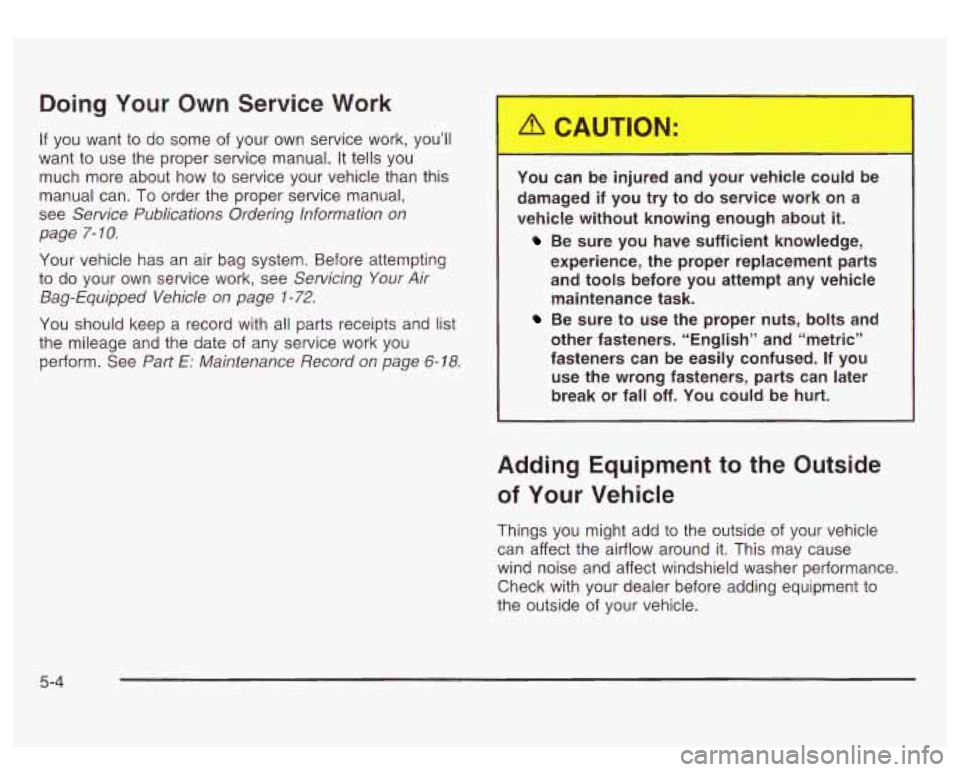
Doing Your Own Service Work
If you want to do some of your own service work, you’ll
want to use the proper service manual. It tells you
much more about how to service your vehicle than this
manual can.
To order the proper service manual,
see
Service Publications Ordering Information on
page
7- IO.
Your vehicle has an air bag system. Before attempting
to do your own service work, see
Servicing Your Air
Bag-Equipped Vehicle on page 1-72.
You should keep a record with all parts receipts and list
the mileage and the date
of any service work you
perform. See
Pat? E: Maintenance Record on page 6- 18.
.3u can be injured and your vehicle could be
damaged if you try to do service work on a
vehicle without knowing enough about
it.
Be sure you have sufficient knowledge,
experience, the proper replacement parts and tools before
you attempt any vehicle
maintenance task.
Be sure to use the proper nuts, bolts and
other fasteners. “English” and “metric”
fasteners can be easily confused.
If you
use the wrong fasteners, parts can later
break or fall off.
You could be hurt.
Adding Equipment to the Outside
of Your Vehicle
Things you might add to the outside of your vehicle
can affect the airflow around it. This may cause
wind noise and affect windshield washer performance.
Check with your dealer before adding equipment to
the outside of your vehicle.
5-4
Page 274 of 428
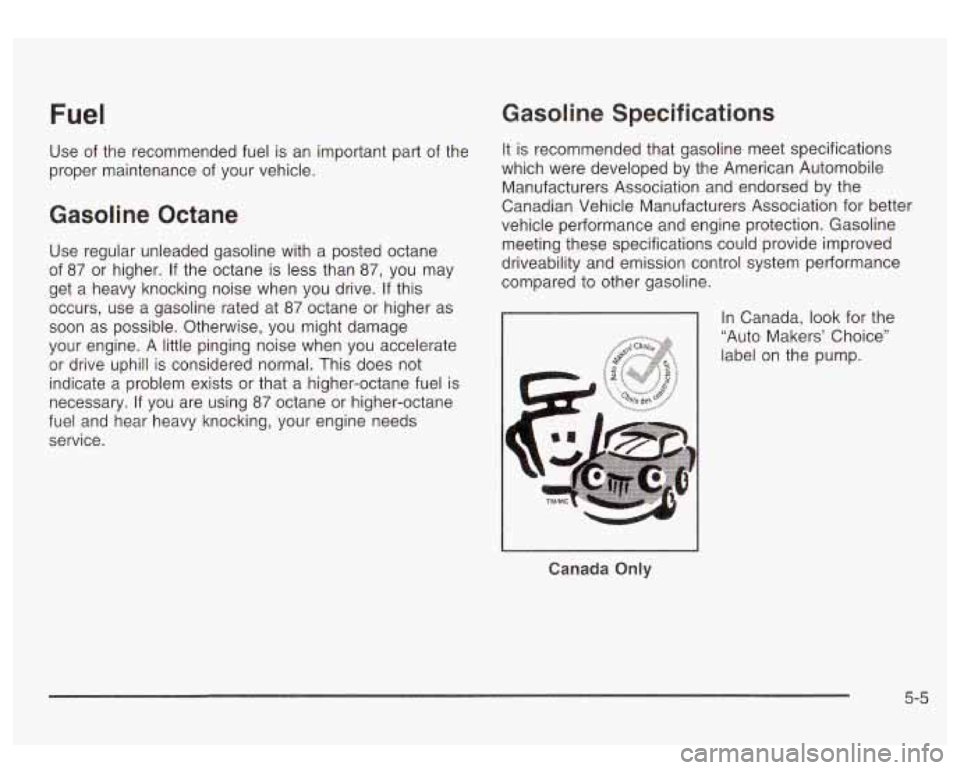
Fuel Gasoline Specifications
Use of the recommended fuel is an important part of the
proper maintenance of your vehicle.
Gasoline Octane
Use regular unleaded gasoline with a posted octane
of
87 or higher. If the octane is less than 87, you may
get a heavy knocking noise when you drive.
If this
occurs, use a gasoline rated at
87 octane or higher as
soon as possible. Otherwise, you might damage
your engine. A little pinging noise when you accelerate
or drive uphill is considered normal. This does not
indicate a problem exists or that a higher-octane fuel is
necessary. If you are using
87 octane or higher-octane
fuel and hear heavy knocking, your engine needs
service. It
is recommended that gasoline meet specifications
which were developed by the American Automobile
Manufacturers Association and endorsed by the
Canadian Vehicle Manufacturers Association for better
vehicle performance and engine protection. Gasoline
meeting these specifications could provide improved
driveability and emission control system performance
compared to other gasoline.
In Canada,
look for the
“Auto Makers’ Choice” label
on the pump.
I I
Canada Only
5-5
Page 289 of 428
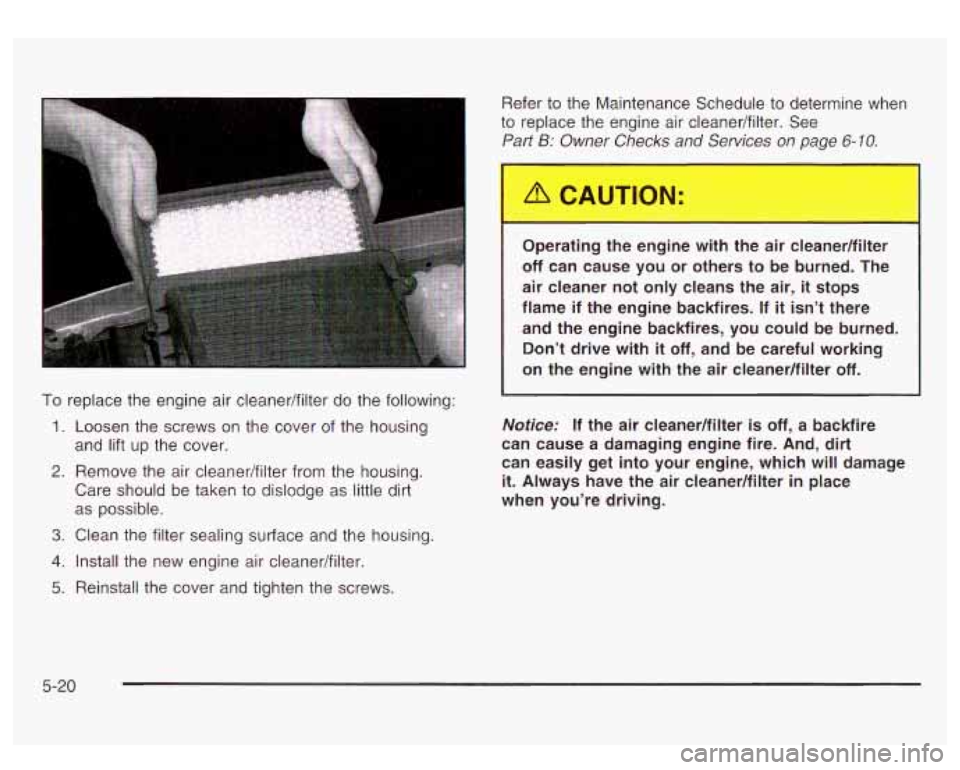
To replace the engine air cleaner/filter do the following:
1. Loosen the screws on the cover of the housing
and lift up the cover.
2. Remove the air cleaner/filter from the housing.
Care should be taken
to dislodge as little dirt
as possible.
3. Clean the filter sealing surface and the housing.
4. Install the new engine air cleanedfilter.
5. Reinstall the cover and tighten the screws. Refer
to the Maintenance Schedule to determine when
to replace the engine air cleaner/filter. See
Part B: Owner Checks and Services on page 6-10.
Operating the engine with the air cleanedfilter
off can cause you or others to be burned. The
air cleaner not only cleans the air,
it stops
flame
if the engine backfires. If it isn’t there
and the engine backfires, you could be burned. Don’t drive with
it off, and be careful working
on the engine with the air cleaner/filter
off.
Notice: If the air cleaner/filter is off, a backfire
can cause a damaging engine fire. And, dirt
can easily get into your engine, which will damage
it. Always have the air cleanedfilter in place
when you’re driving.
5-20